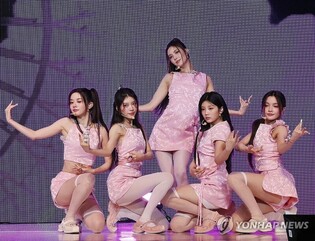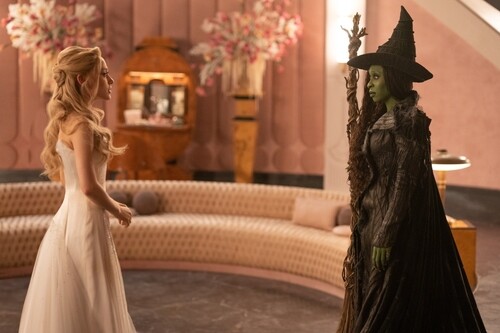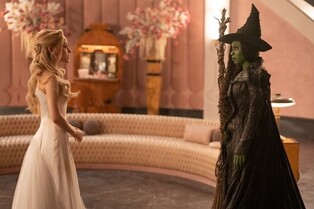*Editor’s note: K-VIBE invites experts from various K-culture sectors to share their extraordinary discovery about the Korean culture.
Chapter 1. The Past
The Ideal Virtual World, Utopian Socialism, and the Chronicles of Utopia
By Noh Seok-joon (Master K-architect engineer)
 |
Ironically, people have long dreamt of realizing utopia in reality. Over the years, various proposals have been put forth from different perspectives. The idea of an ideal society, initiated by Thomas More in the early 16th century, was further developed by French utopian socialists in the early 19th century. During the feudal era, where land ownership determined social status, humans were exploited for the benefit of a few powerful individuals. Despite the Industrial Revolution dismantling feudalism and transitioning to modern capitalism, the exploitation of human labor and economic inequality persisted, leading to significant wealth gaps. To address these issues, 'Utopian socialism' emerged in Britain and France in the early 19th century.
While most utopian socialists' ideas remained theoretical, Charles Fourier's proposals were concrete and realistic. These ideas evolved into tangible forms within communism and socialism, impacting architecture, urban planning, and socio-political systems. However, the extent to which current communist and socialist states adhere to the original utopian ideals of equality and happiness is a separate matter. The institutional efforts to materialize the long-held human desire for a 'perfect, happy world' are indeed fascinating.
Furthermore, humanity is now transcending spatial and institutional utopias, creating new forms of utopia through digital technologies, such as the metaverse.
Robert Owen's Utopian Production Community
In the UK, there were active efforts to realize an ideal society based on Christian principles. Robert Owen, a prominent British utopian socialist, believed that human happiness was determined by character and environment. He established a cooperative enterprise in the small Scottish town of New Lanark, aiming to improve people's lives based on Christian values. His various models of ideal societies were significantly influenced by Thomas More's utopian society and French utopian socialists.
Although Owen attempted to establish a cooperative enterprise in the New World (America), he failed and returned to Britain, where he continued to promote cooperative and labor union movements, albeit with limited success. However, his ideas were highly regarded, with Friedrich Engels praising his theories as meticulously crafted. Owen's cooperative and labor union models continue to influence the present day.
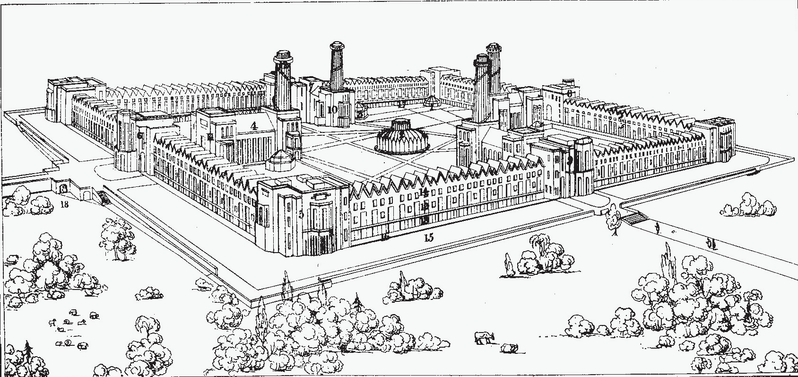 |
| ▲ The New Lanark production community of Robert Owen. |
The New Lanark production community, from 1800 to 1813, served as a large-scale experiment demonstrating the potential of a new community based on improved working conditions, education, and cooperation. Owen believed that humans are products of their environment and can change according to material and moral conditions. Thus, he implemented various utopian initiatives in New Lanark, such as reducing working hours, providing comfortable and convenient accommodations for workers, and establishing public buildings for rest and health, which were unimaginable at the time.
After ceasing operations in 1968, New Lanark was restored in 1974 and designated a UNESCO World Heritage Site in 2001. It has since become a popular attraction, drawing over 400,000 visitors annually.
The factory facilities have been converted into several exhibition spaces, with a central spiral passageway housing an old steam engine and detailed information displayed on the walls. Mill 3 features a rooftop garden offering a panoramic view of New Lanark. Although not part of the original 19th-century development, the rooftop garden was designed by Douglas Coltart, reflecting Owen's views on the environment and nature. Owen is also renowned for his innovative educational system, believing that environment and education significantly impact human character. Therefore, he established a child education facility in New Lanark, now restored as the 'historic classroom.'
From Thomas More to Utopian Socialism
Inspired by Thomas More's utopia, utopian socialists aimed to establish an ideal society based on Christian principles. However, their proposals were often too theoretical, lacking practicality and realism. The utopian society that everyone yearned for seemed destined to remain a figment of the utopian socialists' imaginations, never to be realized in reality.
One of the notable utopian socialists, French-born Saint-Simon, advocated for a society governed by science and industry, unified under religious principles to achieve an ideal state. While his ideas were revolutionary, they were limited by their abstract nature, lacking concrete proposals for practical implementation.
Despite various French utopian socialists proposing the construction of an ideal society, most remained theoretical. Yet, one figure emerged who proposed concrete ways to materialize the utopian visions of the utopian socialists. French philosopher and socialist Charles Fourier suggested architecture and urban planning as tools to concretize the ideal society.
Charles Fourier proposed the phalanstère, a self-sufficient utopian community. The phalanstère was a model of a small-scale producer society aimed at rationalizing production and conserving consumption. Fourier believed that this model could solve all social problems. In the phalanstère, members lived together in the same building, distributing income based on the amount of labor each provided, ensuring a stable life for everyone. The architectural space for communal living simultaneously facilitated work and life, making the ideal society function perfectly.
In designing the phalanstère, Fourier meticulously planned the daily lives of its members. The structure was divided into three main parts: the central section and two side wings. The central section housed communal facilities such as dining rooms, libraries, laboratories, and gardens. One wing was designated for noisy activities like workshops, carpentry shops, and blacksmiths, as well as facilities for children. The other wing contained residential areas, banquet halls, and guest rooms for meetings with outsiders.
Fourier's design included interconnected spaces to promote interaction among family members and neighbors. He thoughtfully planned the interior spaces, using glass walls in corridors for lighting and ventilation. Additionally, to enhance community productivity, he proposed housing workers with the lowest productivity on the ground floor and those with the highest productivity on the top floor.
Fourier also planned the population of each phalanstère, envisioning a community of 1,620 people—810 men and 810 women, each with unique characteristics. He believed that in such a community, individuals' distinct traits could flourish, and work would become a source of joy. Residents could choose any profession and work as much or as little as they wished, with private property allowed to some extent to motivate labor.
Fourier believed that the phalanstère would provide everyone with a comfortable living environment and economic equality. By manifesting the utopian world, previously only a product of imagination, into the concrete architectural space of the phalanstère, he believed that a society where everyone could experience perfect happiness would be realized.
Fourier's use of architectural language, such as plans and elevations, demonstrated his hope for the phalanstère to be realized in the real world. Although his vision remained an innovative proposal, Fourier's urban architectural proposal for an ideal society was significant. It showcased the potential for the utopian and virtual ideas of French utopian socialists to be actualized in a tangible space.
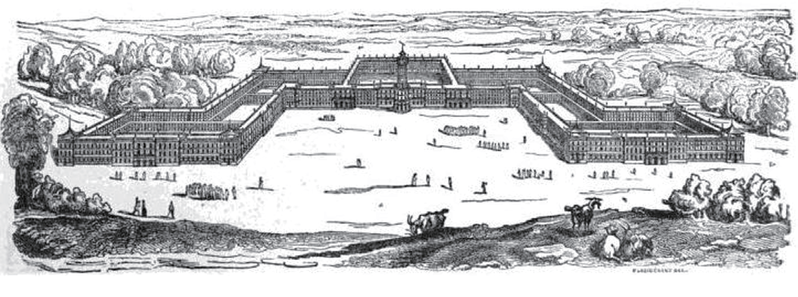 |
| ▲ The phalanstère of Charles Fourier. |
Phalanstère: Utopia Expressed in Engineering Language
Charles Fourier's proposed phalanstère was not only specific and practical but also architecturally nearly perfect. It went beyond a mere proposal to be realized in reality. Fourier's phalanstère was used as a model for communal living structures in communist countries of the Russian Federation and even North Korea following the Russian Revolution. The ideal society, once limited to abstract proposals, was brought to tangible reality through Fourier's urban planning suggestions, materializing in cooperative facilities in communist states.
Various virtual spaces conceptualized to embody ideal societies were reinterpreted and appropriately utilized according to the needs of each era. The phalanstère, for instance, was envisioned as a self-sufficient community facility for impoverished workers overshadowed by the Industrial Revolution. Interestingly, the phalanstère model found utility not only in socialist or communist societies but also in capitalist societies, which pursue markedly different values. In capitalist societies, the purpose of communal living spaces is not to realize an ideal society but to meet practical needs. Examples include luxury resorts, upscale mixed-use residential complexes, and apartments, the representative communal housing in South Korea. Thus, various utopian models were repurposed to fit the urban architectural needs of each society.
One of Fourier's disciples, Philip Hubert, applied the concept of communal housing from the phalanstère when designing a small, convenient apartment for artists in Manhattan, New York, in 1884. Currently operated as a hotel, this building was intended to alleviate New York's chronic housing shortage and facilitate smooth communication among neighbors by creating large-scale communal living spaces.
Moreover, the emergence of the first modern apartment can be traced back to Fourier's phalanstère. The 'Unité d'habitation' communal housing, completed in 1952 in Marseille, France, was designed and built by the architect Le Corbusier. This building, situated on a hill overlooking the Mediterranean, bears a strong resemblance to modern mixed-use apartments in capitalist societies. Housing hundreds of families, it was designed like a small village, complete with schools, hospitals, parks, swimming pools, gyms, and terraces. Each space was purposefully divided into commercial, residential, public, and green zones to maximize comfort and efficiency.
Though commissioned by the state, this building also embodied the strong beliefs of its architect, Le Corbusier. He aimed to create low-cost, high-efficiency communal housing for urban workers, who were then being driven into extreme poverty, while ensuring the space remained as comfortable and efficient as possible. He drew significant inspiration from Charles Fourier's ideal communal living concept in the phalanstère and adapted communal living practices observed in monasteries during his youth.
Le Corbusier's 'Unité d'habitation' and Philip Hubert's artist apartments illustrate how Fourier's utopian vision of the phalanstère transcended its initial conceptual boundaries, finding practical application in various societal structures across different epochs. The realization of these communal living spaces demonstrates the enduring relevance and adaptability of utopian architectural and social concepts.
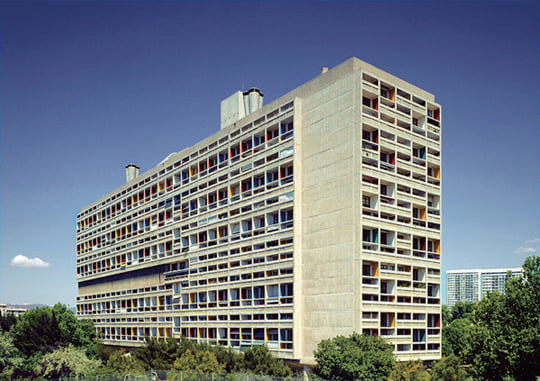 |
| ▲ The 'Unité d'habitation' of Le Corbusier. |
The Future Utopia Intersecting with Science and Technology
One of humanity's most fervent pursuits since its inception has been the construction of a utopian ideal society. The imaginary ideal state, as articulated by Thomas More, has been further refined and detailed by his ideological successors. These myriad concepts evolved into various proposals through writing, illustrations, architectural, and urban planning, eventually materializing in forms of states, political systems, cities, and architectural spaces.
The definition of an ideal society has continually evolved over time. Humanity's passion and hope to construct a utopian society, where everyone can achieve happiness, have consistently driven the creation of new imaginary worlds. Democracy, socialism, and communism are products of such efforts.
A utopian society, while differing in the values pursued by communism, socialism, and capitalism, represents a common dream and ideal that all human societies strive to achieve. Recently, attempts to construct a utopian ideal society have transcended institutional levels, leveraging science and technology. Digital virtual worlds like the metaverse, Elon Musk's endeavors to colonize Mars, and the space utopias envisaged by Jeff Bezos through Blue Origin, all epitomize efforts to build utopian ideal societies grounded in scientific and technological advancements.
The creation of a utopian ideal society, at any moment, necessitates an initial foundation of conceptual and theoretical thought. Following this, meticulous proposals to concretize these ideas are required. The commonality across all these proposals is their foundation in imagination. These numerous imaginary theoretical and practical proposals accumulate and blend over time, ultimately leading to the current possibilities.
Present-day theoretical and practical proposals, when well-integrated with past ideas, will undoubtedly suggest progressive directions for the future. As long as humanity exists, the continuous attempt to build a perfect ideal society where everyone can be happy—whether in the real world or within the metaverse—will persistently emerge.
(C) Yonhap News Agency. All Rights Reserved



















